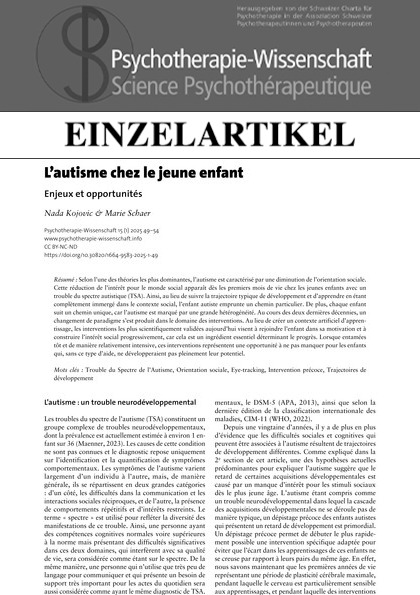L’autisme chez le jeune enfant
Enjeux et opportunités
DOI:
https://doi.org/10.30820/1664-9583-2025-1-49Keywords:
Trouble du Spectre de l’Autisme, Orientation sociale, Eye-tracking, Intervention précoce, Trajectoires de développementAbstract
Selon l’une des théories les plus dominantes, l’autisme est caractérisé par une diminution de l’orientation sociale. Cette réduction de l’intérêt pour le monde social apparaît dès les premiers mois de vie chez les jeunes enfants avec un trouble du spectre autistique (TSA). Ainsi, au lieu de suivre la trajectoire typique de développement et d’apprendre en étant complètement immergé dans le contexte social, l’enfant autiste emprunte un chemin particulier. De plus, chaque enfant suit un chemin unique, car l’autisme est marqué par une grande hétérogénéité. Au cours des deux dernières décennies, un changement de paradigme s’est produit dans le domaine des interventions. Au lieu de créer un contexte artificiel d’apprentissage, les interventions les plus scientifiquement validées aujourd’hui visent à rejoindre l’enfant dans sa motivation et à construire l’intérêt social progressivement, car cela est un ingrédient essentiel déterminant le progrès. Lorsque entamées tôt et de manière relativement intensive, ces interventions représentent une opportunité à ne pas manquer pour les enfants qui, sans ce type d’aide, ne développeraient pas pleinement leur potentiel.
Published
2025-04-03
How to Cite
Kojovic, N., & Schaer, M. (2025). L’autisme chez le jeune enfant: Enjeux et opportunités. Psychotherapie-Wissenschaft, 15(1), 49–54. https://doi.org/10.30820/1664-9583-2025-1-49
Issue
Section
Original Work
License
Copyright (c) 2025 Nada Kojovic, Marie Schaer

This work is licensed under a Creative Commons Attribution-NonCommercial-NoDerivatives 3.0 Unported License.
This journal provides open access to its content in accordance with the basic premise that the free public availability of research benefits the exchange of knowledge throughout the world.
Authors wishing to publish in this journal agree to the following:
- The author/s retain/s the copyrights and consent/s to initial publication of the work in the journal under a Creative Commons Attribution licence, which allows third parties to use the work by citing the name/s of the author/s and this journal as initial publisher (in accordance with the Creative Commons Attribution-NonCommercial-NoDerivs 3.0 DE-Licence).
- The author/s can enter into additional contracts for the non-exclusive distribution (e.g. publish in a collection or book) of the version published in the journal, if the journal is cited as initial publisher.


